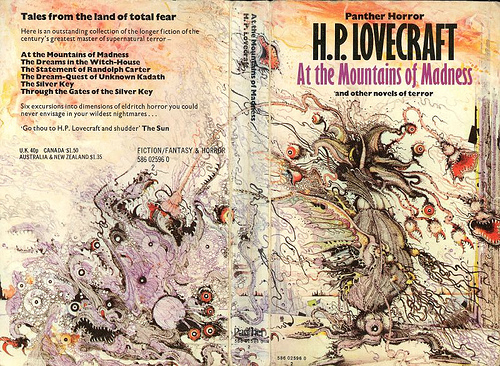I owe my childhood fear of clowns and feral felines to Stephen King. His brick-sized bestsellers dominated my bedroom bookshelves, although I supplemented historical horror with a leatherbound volume of Edgar Allan Poe. I remember wondering who bridged Poe's masterful 19th-century macabre and King's contemporary terror. Today, King's ubiquity remains unchallenged—New York has ranked his entire published oeuvre, and he's got two novels planned for 2013—but contemporary horror trends contain an undercurrent of something unspeakably scarier, originating from the cosmos-chilled, slime-soaked legacy of the writer who not only greatly influenced King, but has his own sub-genre. I give you H.P. Lovecraft.
King himself acknowledges the genre's debt to Lovecraft in his book Danse Macabre: “The reader would do well to remember that it is Lovecraft's shadow, so long and gaunt, and his eyes, so dark and puritanical, which overlie almost all of the important horror fiction that has come since.” With that in mind, I offer this brief primer to help you navigate the Lovecraftian goo.
The Necronomicon
A purely fictional book of the dead that figures greatly into Lovecraft's work. Consider The Case of Charles Dexter Ward and its central tale “The Dunwich Horror.” A librarian senses “a hellish advance in the black dominion of the ancient and once passive nightmare” upon opening the cursed tome. In Sam Raimi's film The Evil Dead, the titular antagonists are (un)wakened by the Necronomicon, while HR Giger's debut monograph(and painting Necronom IV, which inspired Alien's iconic xenomorph) shares the name. Unfortunately, The Dunwich Horror is also a ridiculous B-movie starring Sandra “Gidget” Dee. Tread carefully with “direct” Lovecraft film adaptations.
A fictional Massachusetts town (like King's Castle Rock, Maine) and the setting for Lovecraft's Cthulhu Mythos. Meet “Herbert West—Reanimator,” who proved “rational life can be restored scientifically," and proceed to the decent '85 bloodbath Re-Animator, but I advise eschewing the slasher atrocity The Unnamable, based on Lovecraft's 1923 story. “The Thing on the Doorstep” revolves around Arkham's sanitarium, preceding Arkham Asylumand its gallery of Batman villains, and its personality-shifting plot is a bit Lost Highway. Just think: Lovecraftian and Lynchian!
Indescribable terror
“The Call of Cthulhu” birthed Lovecraft's famous extradimensional, malevolent entity, yet it simultaneously underscored the crippling bafflement of fear. Here's Cthulhu's setup, after a very late reveal: “the Thing cannot be described—there is no language for such abysms of shrieking and immemorial lunacy, such eldritch contradictions of all matter, force, and cosmic order.” Frank Darabont's 2007 film The Mist, based on King's 1980 novella, keeps its besieging, otherworldly fauna masked by the enveloping haze. Jorge Luis Borges, preeminent engineer of enigmas, dedicated The Book of Sand's “There Are More Things” to Lovecraft. The narrator's abstracted inability to describe a house's monstrous inhabitant recalls Lovecraft's scientific barrage of the frozen...things in his singular novella At the Mountains of Madness: in either case, we are no closer to understanding the horror in front of us.
This brings me to Guillermo del Toro's much-delayed dream-project: translating At the Mountains of Madness to cinema. Despite the aforementioned Lovecraft-flavored films, there's little out there that successfully combines “proper Lovecraft adaptation” with “quality viewing” besides 1992's The Resurrected, which didn't even have a proper theatrical run. Del Toro aimed to change this, but after Universal's balking at the blockbuster price tag and Del Toro fearing similarities between ATMOMand Ridley Scott's Prometheus—which draws tellingly from Lovecraft's “Promethean trespass”—its fate is in limbo.
I'm not ready to close this chapter just yet. If Michael Bay gets the OK to helm yet another schlock-and-awe Transformers sequel—whether or not it stars Rosie Huntington-Whiteley—then I say we need a philosophical sci-fi horror film of ATMOM's stature more than ever. In Lovecraft's words from “The Nameless City”:
That is not dead which can eternal lie,
And with strange aeons even death may die.
Main image: H. P. Lovecraft Wiki + ToyVault, photo-chopped by the author; At the Mountains of Madness via The Furnace






 A Black Balloon Publication ©
A Black Balloon Publication ©